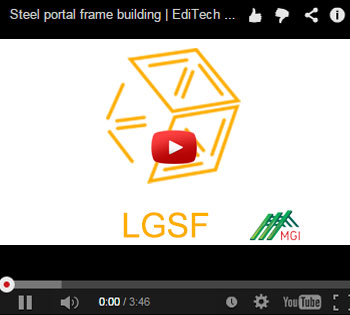Technology Overview
Steel is widely used in the construction of multi-storey buildings. However, steel construction is seldom used and is traditionally considered uneconomical for landed properties. In many parts of the world, timber, structural brickwork and reinforced concrete constructionis usually preferred for landed properties.
Over the years, various improved systems have been developed for use in landed properties. An economical light gauge steel frame system is increasingly being used in America, Europe, Australia and New Zealand. This light gauge steel frame is developed through a cold-formed process without the use of heat. This process enables steel manufacturers to produce light-weight but high tensile steel sheets. The sheet surface is coated with a zinc alloy that completely covers the steel surface and seals it from the corrosive action of its environment. This results in buildings that are more solid, rigid, stronger, durable and easier to build.

Characteristics of the LGSF system:
- The light construction LGSF frame is assembled from cold formed galvanized steel profiles. In the gaps between the elements of the frame heat insulation material is placed and the frame is supplied with surface layers made of various materials, forming a layered structure.
- Generally, the elements of the frame structure are constructed of C profiles with a dry, assembly style building technology. Numerous steel fasteners, stiffeners and other complementary profiles are connected to the basic elements of the structure.
- The applied materials filling the gaps between the elements of the frame not only perform heat insulation, but also meet acoustical requirements and they are an efficient fire protection tool.
Advantages

100% Eco Friendly
Up to 68% less energy is required to erect a modular building as compared to a traditionally built structure. The insulation used in the walls, roof and floor is made of ozone-friendly materials that have minimum impact on the environment.
Fire Resistant
Light steel is non-combustible and will not contribute to the spread of a fire. Our buildings can be designed for 1.5 to 2 hours of fire rating compared to conventional 1 hour of fire rating.

Light Weight
Modular construction is about 30% of the weight of conventional masonry construction, leading to reduced foundation costs. Modular construction is ideally suited to roof-top extensions to avoid overloading the existing building.
Quality Structures
Our buildings are manufactured to very tight tolerances. They have a superior strength-to-weight ratio. LGSF structures can be engineered to withstand extreme loads such as 240km/h winds, zone IV seismic forces under the International Building Code and 3 feet of snow loading. Furthermore, our factory based manufacturing environment consistently delivers superior quality standards through rigorous control of the whole construction process.
Use of Cutting Edge Software
MGI uses proprietary software for design of light steel structures. All the walls, floor joists, roof truss, etc. are detailed to the last milimeter showing the position of the steel sections, their sizes and even the point where one member would be connected to the other.
Less Waste, Greater Recyclability
Light steel reduces waste and subsequently lowers waste disposal and removal costs. Our structural components are fabricated to exact specifications, thereby reducing the amount of excess material. Any waste generated is recycled in the production centre. Steel is 100% recyclable, hence does not contribute to depletion of natural resources or degradation of environment.
Enhanced Thermal Efficiency
Compared with conventional brickwork, our insulated walls conduct 90% less heat, ensuring that the interiors remain cool during the summer and warm during the winter. The steel frame design minimizes thermal bridges, making the buildings easier to heat or cool with significantly less use of energy.
Expeditious Construction
Time taken for construction can be reduced by up to 50% using modular building techniques, which translates into earlier return on investment.
Insect Damage Resistant
Steel is also impervious to termites. Since steel is not a food source for insects such as termites, structures built with LGSF technology provide greater resistance against termite damage than structures built with traditional materials, such as wood.
Dimensional Accuracy
Small tolerances can be achieved and maintained within the module interior and in the sizing and positioning of openings. This leads to ease and accuracy of fit-out in a production environment.
Safer Construction
Modular construction sites have proved to be significantly safer than traditional sites because of the more controlled operations and less site labour.
Use On Infill Sites
Modules are useful in small urban infill sites, particularly where it is uneconomical to build because of problems of disturbance and site location.
Adaptability Or Extendibility
Adding modules to, or removing modules from, modular buildings is typically a very rapid and straightforward process that involves the minimum of disruption to the operations of adjacent buildings.
Allergen-Free, Mould-Free And Toxin free
Allergen-Free, Mould-Free And Toxin free
Seismic Properties
Steel structures are supremely robust, which means that they are more resistant to seismic loads than conventional buildings and more than meet international standards for every seismic zone.
Who Benefits

Individual & home owners
- Early occupation of home meaning substantial saving in interest on loans and rentals.
- High strength results in safer structures, less maintenance and slower aging of structure.
- Not vulnerable to any type of fungi or organism.
- Less probability of foundation problems - less weight results in less movement.
- Not vulnerable to termites.
- Less probability of damage in high winds – stronger connections, riveted and screwed versus nailed.
- Fire Safety.

Builders & Govt. bodies
- Lighter than other framing materials – no lifting equipment required on site. One person can easily carry a 5-metre fabricated panel
- Easy material selection - no need to cull or sort.
- Straight walls and Square corners
- Call backs due to cracks are eliminated.
- Small punch list.
- Less scrap and waste (2% for steel vs. 20% for Cement).
- Price stability
- No drying out period in wet weather, resulting in no delays.
- Extra floor space - Due to reduced thickness of external walls compared with a double skin brick wall (some 6%).
- Extremely Accurate - Light Steel Frames dictates a high degree of accuracy of building dimensions. Being computer designed and rolled, the allowable tolerances are minute (as low as 5mm), thus ensuring a perfect building every time.

General indirect stake holders
- More steel recycled in India and other countries each year than aluminium, plastic and glass combined - with the industry's overall recycling rate of 64%.
- Every ton of steel recycled saves 2,500 pounds of iron ore.
- Green Building - Through the basic oxygen furnace steel making process, steel framing uses a minimum of 25% recycled steel.
- Requires less than half the electricity to heat and cool to thermal comfort levels than brick houses
- No toxic chemicals are used to treat steel, unlike the treatment of timber
- Minimal wastage - Almost all cutting and sizing is done in-factory by automated machinery. The material wastage is zero. Any waste steel can be are recycled. The Light Steel Frame buildings come in already completed frames ready to be erected on site.















